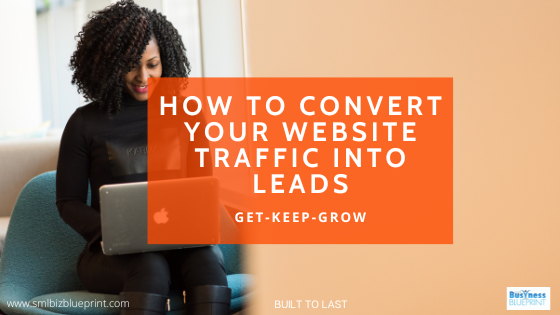How are you attracting visitors to your website?
These can be achieved in a variety of ways including
Paid Ads
Social Media
Content Marketing
Organic Search
Apart from paid ads, the other alternatives do require you to do some form of content marketing or blogging.
While your site might already bring you a steady flow of traffic, likes, and comments, what about conversions?
Hopefully, your goal is to convert those visitors into leads.
It’s only when your traffic leads turn into conversion prospects that your content marketing efforts become worthwhile; everything else is just vanity metrics.

Let’s look at the stats to understand the importance of content marketing when it comes to lead generation:
Orbit Media’s annual blogging survey found that 77 per cent of bloggers say blogging delivers results.
According to HubSpot,60 per cent of consumers regularly read blog content.
Content Marketing helps drive traffic to your website.
Here’s how it works.
Think about how many pages there are on your website. Probably not as many as you would like. And think about how often you update those pages. Probably not that often.
Well, content marketing is a great way to solve both of those problems.
Every time you create and publish a blog post, it’s one more indexed page on your website, which means one more opportunity for you to show up on the search engine results page (SERP) and drive traffic to your website in organic search.
It’s also one more cue to Google and other search engines that your website is active, and they should be checking in frequently to see what new content to surface.
You can repurpose your content for social media.
Blogging for your business also helps you get discovered via social media.
Every time you create a new article, you’re creating content that people can share on social networks — Twitter, LinkedIn, Facebook, Pinterest — which helps expose your business to a new audience that may not know you yet.
Content also helps keep your social media presence going.
Instead of asking your social media manager always to create brand new content for social media (or creating that content yourself), your blog can serve as that repository of content.
You’re strengthening your social reach with content and driving new website visitors to your blog via your social channels.
So how do you convert those visitors or readers to leads for your business
Newsletter Signups
Once you’ve built a popular blog with your content, your readers will want to stay updated with new content.
You should encourage them to take action and sign up. However, don’t use newsletters to send them offers.
Value their trust and keep them updated with the new content just as they expect. As a result, they’ll be more receptive to occasional offers and convert more easily.
The most popular ways to collect newsletter signups are navigation bars, static ads, pop-ups, and sliders.
Call To Action
Use Call to Action to recommend next steps, related content, or related offers.
A blog is typically a good place for CTAs because it is a section of your site you continually update, bringing in new visitors who translate into new potential leads.
While you probably won’t convert a first-time visitor to your blog, the chances of converting a returning one are high. In any case, as a marketer, you want to stay loyal to the ABC (Always Be Closing) rule.
Also of note: make sure they lead a prospect to the relevant page or landing page designed specifically for that purpose.
Lead Magnets
A lead magnet is content your prospects find valuable enough to give you their contact details and an opportunity to develop a business relationship to get it.
Someone filling out a form to download your latest eBook or white paper is undoubtedly considered a quality lead.
Not only have they visited your website, but they’ve also found your content so interesting that they want to learn more.
Lead magnets are a powerful conversion tool. Because they provide a lot of value, you can ask for more than just email (e.g., job title, phone number).
You can take it a step further and qualify your leads by asking them to answer one or two questions that will allow you to split curious eyes from actual leads. For example, asking how many employees work at their company or what their role is at a company will help you spend time on the leads most likely to convert.

Remarketing
Remarketing is advertising to an already existing audience. It allows you to drive back lost website visitors.
The remarketing funnel groups users based on their actions on your site, i.e., viewing three or more product pages, spending more than one minute on a product page, or viewing three or more blog posts in one session.
Then you can target these visitors with different offers in hopes that it leads them to take action.
As it is with advertising, one thing you have to keep a close eye on is your customer acquisition costs—you want to make sure you have a positive ROI.
Use Retargeting to Reach Back Out
Despite your best efforts, a sizable chunk of traffic will leave without filling out a form. It’s just the nature of online marketing.
Maybe they were pressed for time, or your offer wasn’t compelling enough, or they simply missed it.
That’s where retargeting comes in. It gives you another chance to close the deal.
So how does this work
Essentially, a tiny string of code called a pixel is placed on your website. This pixel drops a tracking cookie on every visitor’s browser to your blog, and it then follows them around the internet.
Ever notice an ad for a product you were looking at on Site A in the sidebar of Site B or on your Facebook feed? That’s retargeting doing its thing.
The pixel follows them and displays relevant ads to draw them back to your blog or landing page. You get a second chance to convert them.
Marketing tools like AdRoll, ReTargeter, and Perfect Audience allow you to pixel your existing visitors and target them with relevant offers on websites outside your blog.
The efficiency of your retargeting depends on how good your ads are. Each ad needs to have a clear and powerful copy, a visible CTA and needs to direct your prospects to a landing page where they’ll then convert.
Remarketing is an effective way to stay top-of-mind with your website visitors long after they’ve left your website, and drive them back to convert.
Focus on Buyer Personas
A customer or buyer persona is a fictional person that represents the needs and desires of your target audience. The purpose of a customer persona is to help you make design and content decisions for your product or service.
Creating customer personas is crucial because they help you identify what content will resonate with specific customers. It also helps you create a more personalized content strategy for each type of customer.
To create your buyer personas, think about the main characteristics and demographics of the leads you want to target.
For example, if you run a marketing blog, one of your personas may be a woman in her mid-30s who is a mid-level marketing professional.
Do some research based on your own analytics tools or via social media to find out what someone in this demographic is interested in, spends their time doing, what they typically read on the internet, what motivates them, etc. Flesh out your persona with these details.
Content Upgrades
The content upgrade is a relatively new term in content marketing, although it’s a strategy that’s been around for a while. The concept is simple.
Let’s say a potential customer reads a blog post on your website, and they love it and want to learn more.
The article is valuable and offers very efficient how-to advice.
Somewhere in the middle of your blog post, you offer your readers a free download of a simple checklist or a list of resources needed to execute the advice in the article.
And that’s it. A content upgrade can be anything that adds to the article: a checklist, a list of resources, or simply a more interactive PDF version of the article. It’s a great way to turn someone who’s already interested in what you have to say into a new lead you can nurture further.

Format For Skim Readers
Should be considered for all your blog posts regardless of their purpose.
We all have limited attention spans, so you need to cater to readers who prefer to skim through content by drawing their eyes to the important parts. Nowhere is this more important than in a post you want to use to drive conversions.
The rules are pretty standard:
- Write in short paragraphs – no more than three sentences is generally advised.
- Use subheadings, bullet points, and numbered lists wherever appropriate.
- Choose a font and size that’s clearly legible.
- Use images to break up the text and illustrate your key points.
Use boldface for sections of text or CAPITALIZING words to which you particularly want the reader to pay attention.
Create Content According to Buying Cycle
Customers go through the buying cycle before they finally decide to make a purchase, generally following this pattern:
Need– Customers are aware they need something, they’re just not 100% sure what it is yet.
For example, Shopper A just had his dishwasher stop working. It’s a problem that they need to fix, but they don’t know how.
Initial research– The customer tries to find a solution.
In this case, they will probably first look to figure out if a repair will suffice or whether they’ll need to purchase a new machine. They recognize a new dishwasher is needed and do research to find a model that fits their budget and offers the best quality for that price.
Final research– The customer has found a solution; all that’s left is choosing where to purchase it.
Purchase– The customer makes his purchase.
If your goal is creating blog content that converts to sales, you’ll generally be targeting consumers who are at the initial research stage. Your job is to provide the information and answers your visitors are looking for; however – and this is the key – you want your content to be so persuasive and instil so much confidence in your audience, that the post takes them through the final research stage and straight to a purchase – with you.
This is why blog content designed for conversions is almost always long-form – long-form content gives you more time to engage your readers, gain their trust, and demonstrate that you have the product or service that will meet their needs.
Let’s look at the content for your sales funnel
Top of the Funnel (TOFU)
Here, everything is about building brand awareness. It is your first interaction with a potential customer, so you should try to establish trust.
At this stage, the customer has a problem and is looking for information. Probably, users never explored neither your business nor industry. They do not think about completing sales, but their time will come.
Imagine you are just walking on the streets and partially glancing at the counters of shops. If you want to catch these customers, you need to provide content around the awareness stage. So, you should search for queries for the initial stage and provide helpful erudition.
Middle of the Funnel (MOFU)
A potential customer has realized the need to fix a problem and is exploring the options. But the tricky point is that they are not sure what and where to buy. From here, you should start appearing under the nose of readers. They are valuable to you. Try your best not to let them go.
Bottom of the Funnel (BOFU)
People have become acquainted with your business, read the articles, and take the initiative. They are seriously considering using your product or services. Now, your focus should be on selling. Send them case studies, demos, free trial offers, etc.

Choose Topics That Resolve Pain Points
The best blog topics for driving conversions are those that answer a question or help a customer overcome a pain point. For example, you might target visitors who want to:
- Make more money
- Improve customer service
- Boost self-confidence
Topics based around pain points drive conversions because they target visitors who are seeking a solution to a problem – they’re likely already in a “buying” state of mind.
That said …
Don’t provide all the answers.
You should provide a detailed framework for solving a problem through the information that’s useful and actionable.
But, you should leave room to include firm calls to action that entice visitors to learn more or gain further assistance by completing your desired action – whether that’s making a purchase, downloading a freebie, signing up for a free trial, or even just joining your mailing list.
However, once potential customers are on your site and interested in what you have to say, they are encouraged to invest in your e-book.
Establish Brand Authority
How do you want your customers to perceive you?
It takes a lot of effort to position your company as an authority in your industry and an expert on your services. Blogs are a great way to showcase your knowledge. Customers and prospects want it.
Do your best to help your readers and share your knowledge. If you, have it, why not share it? You can benefit from your business’s trust and referrals by “helping first”.
Bottom line: brand authority is important. Blogging can be a great way to increase brand value and show off your knowledge.
Strategy is crucial.
Focus on these things when you blog to build brand authority:
- You should think about the needs of your audience and target market. How can your products or services help them?
- What are your buyer’s pain points? How can you help these buyers solve their problems?
- You might think about the most common questions that people have about your products or services. Is it possible to create content that gives useful insights and answers?
Insert Live Chat
The trouble with blogs sometimes is that your readers and subscribers may be interested in what you offer and are not able to get the information they need.
Many are eager to know more about your product and search for answers on your blog but may not be able to navigate to the answers by themselves.
This is where Live Chat comes in useful. Live chat makes it convenient for your customers to make an informed choice.
It makes it easier for them to ask questions about your products and services and gives them instant access to the information they need to make a buying or subscribing decision.
Live chat is known to increase sales by being able to provide customers with the help they need to complete a sale until the end.
With your content aim to attract potential customers and make them want to learn more.
Think about who you want to reach and what they want to see to achieve your site traffic/conversion goals.
Once you get them to your site focus on converting them to leads.

